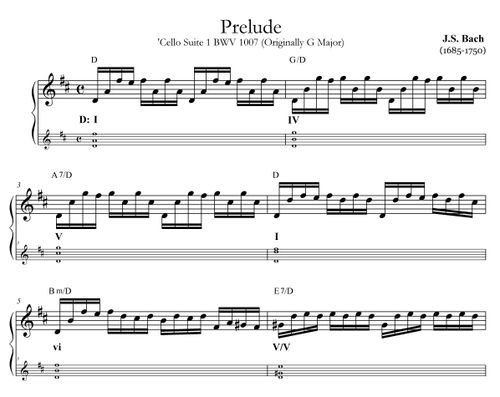Purchase and download the complete analysis (D and G major) for $5.00 using the link below:
Buy Prelude 'Cello Suite 1 BWV 1007 Analysis
The solo 'cello suites of J.S. Bach are so well known and often played by guitarists that I thought it would be worthwhile to do an analysis of the Prelude to 'Cello Suite No. 1, BWV 1007. I include two versions in the pdf's above; the original 'cello version in G major in bass clef as well as a transposed version for guitar in D major placed into the treble clef for ease of reading. Nothing has been added in the way of extra bass notes. I used the original 'cello version as it appears in the Neue Bach-Ausgabe.
The analysis uses two staves. The upper is the actual music and the lower is the reduction analysis in which the music is reduced to show the underlying voice-leading and harmonic structure similar to what Heinrich Schenker would do. I included some bass notes in the reduction staff which I believe are there by implication only. You can let me know whether you agree or disagree with these choices.
I will refer to the D major version in the following discussion. My apologies to the cellists.
This Prelude consists of two sections: Part 1 (mm. 1-22) and Part 2 (mm. 22-42).
Part 1 (mm. 1-22)
Notice the voice-leading in the outer voices in the reduction staff. The bass begins on the tonic (D) sustained as a pedal point through measure six.
The bass then begins a step-wise descent all the way down to the F# (by implication) in measure thirteen (V/vi) before returning to D in measure sixteen.
The upper voice follows along a tenth above the bass through measure ten before veering off and moving in contrary motion with the bass in measures 11-16.
In measures 16-20 we move through several secondary dominants before arriving on the true dominant (A7) in third inversion in measure twenty-one prolonged through the fermata in measure twenty-two.
Part 2 (mm. 22-42)
The second section consists harmonically of one long dominant seventh chord (A7) eventually resolving to tonic in measure forty-two. In case you were wondering, the G that was in the bass in measure twenty-two is transferred up two octaves in measure twenty-three (shown by dotted slur) before resolving as it should to F# in measure twenty-five.
Along the way we get a little taste of D minor (parallel minor) with the introduction of the Bb in measure twenty-four as well as another secondary dominant (V/V) in measures 26-27.
The new discoveries for me occur in measures 29-37.
First, the underlying 7-6 suspensions over the A pedal point in measures 29-31 went completely unnoticed by me as well as the ascending and descending thirds in measures 31-37.
Finally the big finish involves the chromatic ascent in the upper voice which transfers the C# up an octave before its final resolution to tonic in measure forty-two. Remember, the tonic 6-4 chord (D/A) in measure thirty-nine is really still considered dominant with a double appoggiatura which does resolve (by measure forty-one) to the dominant seventh and then finally the tonic in measure forty-two.
Once again I hope you find something in this analysis that is useful or enlightening in some way. I am always amazed when I look into Bach's music. It must have something to do with 18th century German beer.

